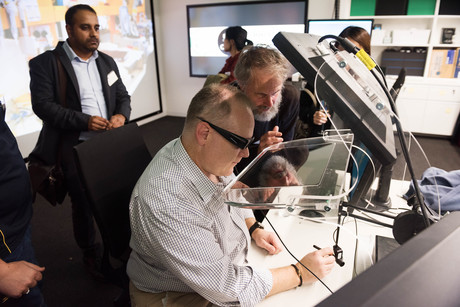CSIRO launches immersive AR lab

CSIRO’s Data61 has opened an Immersive Environments Lab, a facility purpose-built for applied research into novel augmented reality, virtual reality and 3D web technologies — industries set to be worth $143 billion by 2021.
The Lab, which is part of CSIRO’s new $100 million research facility in Canberra, will allow researchers to develop new interactive computer graphics and computational imaging services, which will redefine industries including retail, agriculture, manufacturing, health and construction.
CSIRO Data61 Senior Research Engineer and Experimental Scientist Matt Adcock said AR and VR technology would change the way Australians interact with digital systems at work and at home, such as enabling emergency services to ‘beam in’ to help administer first aid, to allowing maintenance workers to interact directly with smart buildings, and tapping into vast catalogues of 3D data.
“AR technologies can sense elements of the physical environment and enable delivery of holographic data right where and when it is needed most,” said Adcock. “Some smartphone apps already let users see, for instance, what furniture would look like in their own home.
“But while the hardware is evolving at a rapid pace, the digital services that can run on that hardware are just beginning to be explored.”
The Lab itself features a fleet of wearable holographic computing devices, spatial cameras, 3D object scanners, haptic (virtual touch) displays, interactive projection mapping stages and motion capture rigs.
The CSIRO building which houses the lab contains a cloud-based smart glasses system, developed by Data61, which displays historical and real-time energy usage data overlaid directly on the appliances consuming the energy. It is an indication of what is possible in smart buildings of the future.
“We’ve also developed an application for the Powerhouse Museum that uses our multi-user AR techniques,” he added. A tour guide is able to share a virtual holographic experience with a tour group through smart glasses.
“While the tour guide controls the general narrative, and the holograms appear in exactly the same place to everyone, each individual can investigate specific aspects of the museum objects for themselves. This is a whole new way of collaboratively experiencing museum collections.”
Data61 is already working on AR projects related to health, future cities, education, agriculture and manufacturing, to name a few.
The Immersive Environments Lab is also collaborating with Australian SMEs which are aiming to be early to market with new AR services and government partners that are adopting research from the Lab.
Data61 CEO Adrian Turner said the Lab was a unique facility with connections into Data61’s deep expertise — in areas such as decision sciences, data sharing and visualisation, collaborative systems, Internet of Things, machine learning, in-situ analytics and robotics — as well as CSIRO’s domain expertise in manufacturing and agriculture.
“Augmented reality now is where the web was several decades ago — on the cusp of broad adoption, as the technology and compelling use cases have matured,” said Turner.
“The Immersive Environments Lab will facilitate collaboration between industry, government and universities to place Australia at the forefront of this next wave of technology which will reinvent our industries and create new ways of working and playing.”
Vaxxas secures TGA licence to manufacture vaccine patch technology
Milestone enables GMP manufacturing to accelerate clinical trials and transform global vaccine...
DroneShield nabs another European military contract
DroneShield has recently announced it has received a new contract for AU$49.6 million for...
Daikin Australia opens new Sydney factory
Daikin Australia has opened a new factory in Chipping Norton that aims to accelerate the...







